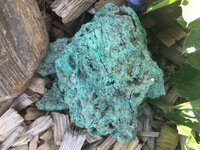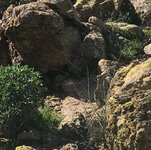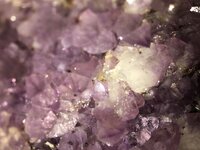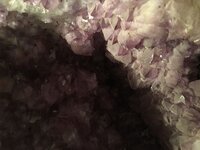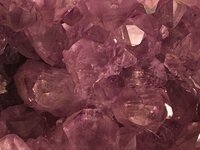Matthew Roberts
Bronze Member
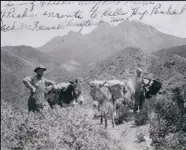
James (Jack) McDaniel's and his partner Wm. Edwards near their Amethyst Mine in the Four Peaks country circa 1909.
There is credible evidence to believe this mine was being worked by Spanish / Mexican miners in the 18th Century (1700's).
For centuries, amethyst has been considered the royal gem because of its color. Purple was the emblem of rank or authority and the color most often associated with European monarchs. Spanish recorded history shows the discovery of a Four Peaks lode in the 18th century (1700’s) and significant shipments of these gems to Madrid, Spain where they found their way into crown jewels of five countries.
In October of 1900, a Phoenix prospector named James (Jack) McDaniel’s was looking for gold near Four Peaks He was following some quartz "float" on the southwest side of Four Peaks in the Mazatzal Mountains. Quartz float is usually a good precursor to gold. Instead he found the canyon floor littered with strange purple crystals. McDaniel’s followed the lead and discovered a covered mine working that later proved to be an old Spanish / Mexican mine. The location of the mine was in one of the most remote and rugged parts of the Mazatzal Mountains.
McDaniel’s and a partner laid claim to 20 acres at the mine site and began digging out valuable Amethyst crystals which they sold to Jewelry and rock shops in Phoenix, Mesa and Tucson.
The site is easily identifiable due to the extensive mining activity that took place there in the last 117 years. The location is best seen with binoculars on a dirt road to the west and is between the two southern-most peaks. After finding the mine between these peaks, drop down slightly to see the mine's large waste rock slope. The best time for viewing is in the late afternoon or after snow has fallen on the peaks. In either case the relative smoothness and lack of trees on the slope distinguishes the spot from the surrounding rugged, brushy area. The mine site itself is at the top of the slope, only 400 feet below and slightly to the right of the notch between the two peaks.
The mineral and geologic Record of March 1976 describes the process by which these crystals were formed. "The amethyst of this deposit occur in linings of voids in faults of the Mazatzal quartzite. The voids were intermittently filled with hot liquid solutions from intrusions below. Successive stages of quartz deposition occurred, as evidenced by alternating concentric rings of colorless quartz, hematite and amethyst around the angular fragments."
The purple color that enhances the quartz is caused by the presence of manganese in these hot solutions that flooded the cavities in the uplifted peaks millions of years ago. The more valuable darker colors reflect a higher manganese content. The value is also dependent upon its clarity or lack of foreign material in the solution as it was being deposited.
Arizona is the only state in the U.S. which produces top quality stones, according the Ken Phillips Chief Engineer for the Arizona Department of Mines and Mineral Resources Department. He further says, "The best amethyst from the Four Peaks mine is considered to be as fine as that found anywhere in the world." Another reference book, Mineralogy in Arizona, states, "Superb gem-quality amethyst of a rich, red-violet color was produced from the Four Peaks mine and rivals the best Siberian material, which is the standard of the gem trade."
Blasting with dynamite in the deposits is not an option, since it would shatter the crystals although it is sometimes utilized to remove surrounding rock formations. Hand tools must be used for the slow and tedious extraction method. The only access to the site is by helicopter or by long, difficult trails.
For many of the more recent active mining years, helicopters were used to bring in workers and supplies and take out the gems. For about 18 months 4 mules were used to replace the helicopter, trudging over trails to the nearest Forest Service Road. It is believed that this is the only precious stone mine in the world that requires a helicopter to bring in tools and remove its products from the site. It is also at what is likely the highest elevation of any gem mine in the USA.
There have been several owners of the Four Peaks Amaethyst Mine. Even though the amethyst vein was producing high quality crystals, problems were plentiful, most of them attributed to the rugged and inaccessible wilderness location of the mine.
Jim McDaniel’s was the discoverer of the mine in 1900 and held the rights until about 1920 when he transferred the rights to Gertrude Evelin of Phoenix. In May of 1925, Gertrude Evelin sold the mineral claim on this 20 acre parcel of land to Louis and Rudolf Juchem, brothers who were stone cutters from Germany but then living in Los Angeles.
A mining publication of that time reported the price as $2,500.00 to be paid at $50.00 per month. It was also stated that they wanted no publicity on the sale. The land was patented to private ownership in 1942. They called their mine the "Arizona Amethyst Placer."
In 1955 when they filled out the annual report to the Arizona Department of Mineral Resources, the Juchem brothers said that the minerals produced there were "amethyst crystals" and "axle grease mica". They also stated that the mine would be for sale soon due to health problems in the family. About that same time, Bob Dye leased the property and operated it for seven years.
Mr. Al W. Storer and his wife, Cecile, purchased the mine in 1963 and worked it for many years. Speculation in mining publications at the time put the sale price at about $50,000.00. The Storers operated the Rock Hobby Shop in Phoenix, then the House of Amethyst gem shop in Scottsdale and later in Fountain Hills.
During the late 1960's and 1970's, a helicopter delivered supplies to the miners who generally stayed on site, returning to the Valley only on weekends. The crystals were carried out on the return trips. A corrugated iron shack was built near the helicopter pad as an equipment shed and to provide shelter for the miners as needed. The terrain was so steep that the downslope portion of the building had to be supported by poles about 16 feet long. This shed would clearly be seen from Fountain Hills and Rio Verde as it reflected the late afternoon sun.
On September 21, 1972, the mine was sold to a Phoenix resident, Joe Hyman. In September 1976, he received a letter from the Arizona Mining and Mineral Museum in appreciation for the receipt of 13 amethyst stones and crystals, some of which are still on display there.
On March 3, 1977, the property was sold to Darrell E. Smith who operated it under the name Maricopa Mining Corporation. Unverified news stories at the time noted that Smith paid about $100,000.00 toward a purchase price of $350,000.00.
As early as November 1976, Smith was apparently planning the mine purchase. In that month he filed a "Notice of Intention to Operate on Public Land" with Tonto National Forest officials. He wrote a letter stating that the cost of the helicopter access was becoming prohibitive and that the only practical way of working the mine was with a heavy bulldozer.
He further said that he had a D-8 Caterpillar positioned in a desert wash just 125 yards away from a spot where it could be "walked in" to the mine itself without again lowering the blade. He wanted to build a road over this short distance, and agreed to smooth over and to plant grass seed on the disturbed soil.
In June of 1977, permission was given to transport the D-8 for one time only into the property and back out by the same route when the mine work was done. This letter from H.R. Nickless Tonto Forest Ranger, specified that "under no conditions should the blade be dropped to move any soil or vegetation."
On August 1, 1977, an angry letter from Mr. Nickless told Mr. Smith that the Tonto Forest officials were aware that he had started a fire below his mine on the previous Saturday. Forest officers inspecting the damage also noticed that he had caused a significant amount of disturbance to National Forest land in moving the tractor to the mine. The road scar created by the bulldozer on the mountain below and to the left of the tailings slope can still be see in the late afternoon or just after a snowfall.
On October 31,1977 Ken Phillips and Art Bloyd then curator of the Mining and Mineral Museum, were at the mine site. They were evaluating the quality of crystals that had previously been discarded. As Phillips pointed out during a 1997 interview, "while the best crystals from there were outstanding, there was a significant amount of lesser grade material that was good enough to be profitably retrieved."
While Phillips and Bloyd were still there, Smith was operating his leased Caterpillar on the rock dumping area. It was steep and the material so loose that the D-8 overturned, sliding down the slope about 200 feet. Miraculously Smith was unhurt but the tractor lost one of its tracks.
The tractor was leased from Empire Machinery of Mesa. They had to send a four-man crew to retrieve the machine. Orville Schubert, a retired Empire employee, remembers the scenic helicopter ride as repair parts and tools were flown to the site.
Others drove as far as possible and hiked on up the mountain. A new track was mounted with other repairs and maintenance as required. Dynamite was used, with Tonto Forest approval, in rebuilding part of the trail to allow a safer route down the slope. Two full days were needed to accomplish the task. The crew slept in the open at an elevation of about 7,100 feet on a very chilly night, "with only sleeping bags and a camp stove," Mr. Schubert said in a 1997 interview.
On the way out a Tonto Forest Ranger was following closely to assure that no more damage would be done to the terrain and that no fire would be sparked. As the tractor was being brought off the mountain, it nearly overturned on three occasions. Mr. Schubert was the driver and he recalls, "I was plenty nervous I was setting very lightly on that seat and ready to jump."
While these events were occurring, a letter was written from the Precious Minerals Corp. of New York City where Smith had sent samples for analysis. The expert there, Frank P. Jaeger, advised him that, "The color of Four Peaks gems do in fact come up to African amethyst. Hang in there, Darrell, because I really think you have a winner."
In a subsequent story for Gems and Minerals magazine Jeager says, "The amethyst produced at Four Peaks is distinctive...exquisite material even the lilac colors have more 'zip' then the average."
Ironically, just as Mr. Smith was receiving these emphatic endorsements, the Tonto National Forest Service revoked his operating rights because of his damage to the wilderness outside the mine boundaries.
Ownership of the mine later reverted to Mr. Hyman. Since the early '90's the mine has been closed due to the increasingly high price of helicopter access and the difficulty of gaining access to the remaining deposits. However, it has been known that rich veins of crystal still exist deep inside the quartzite voids.
The mine site has been gated and trespassing prohibited. Injuries to trespassers have occurred at the site and, on several occasions, hikers have become stranded. Persons have been arrested when they disregarded the posted notices. Four men were sentenced in Mesa on February 4, 1969. One was put on probation for several years and prohibited from entering the Tonto National Forest in the Four Peaks vicinity. In recent months another trespasser was prosecuted.
In December 1997 the mine was purchased by a New Jersey resident, Kurt Cavano, and his London-based partner, Jim MacLachtan. They became acquainted with the quality and availability of the mine's product at the national gem show in Tucson last year. The partners will operate the mine as the Four Peaks Mining Company.
Mr. Cavano is a graduate biologist and has expressed a strong desire to manage the mine in a sound, environmentally-sensitive manner. If at all possible, some of the past mining scars will be re-vegetated by working closely with the Tonto National Forest personnel. Jack Lowell of Phoenix-based Colorado Gem and Mineral will manage the on-site mining activity.
This author visited the mine in May 1998 at the invitation of the persons involved in the business. The Caterpillar track that was thrown in the 1977 accident is still there.
The former mine opening has been covered by a rockslide and a new opening made above and to the south. The waste rock slope occupies a large part of the site extending at least 150 yards down the ravine that separates the two southern peaks.
The geological formations around the mine location are striking. The rock layers have been uplifted to a nearly vertical position and others have been twisted and convoluted into grotesque shapes. It is possible to imagine how voids and cavities could have been created during the violent formative period. These quartzite structures are among the hardest forms of rock and provide the resistance to erosion that has preserved the elevation of Four Peaks. The tops of the Four Peaks are Precambrian granite the oldest rock in the world.
Two trained miners work the veins at the present time and they stay inside the shaft to avoid the ecological impact of any structures at the site. They make the long hike to and from the mine, generally staying 7 days at a time. They are supplied with water, food and tools by helicopters which also retrieve the uncut crystal. The miners still use only hand tools to extract the precious stones.
Observation of the matrix in which the amethyst is located verified why the Juchem brothers said in 1955 that the mine produced "axle grease mica". The rocks are a deep purplish-black due to their high manganese content. They are also slick and "greasy" to the touch, making the amethyst crystals easier to dislodge once they have been located.
* Many thanks to Robert Mason for research work done with the Four Peaks Amethyst Mine.



